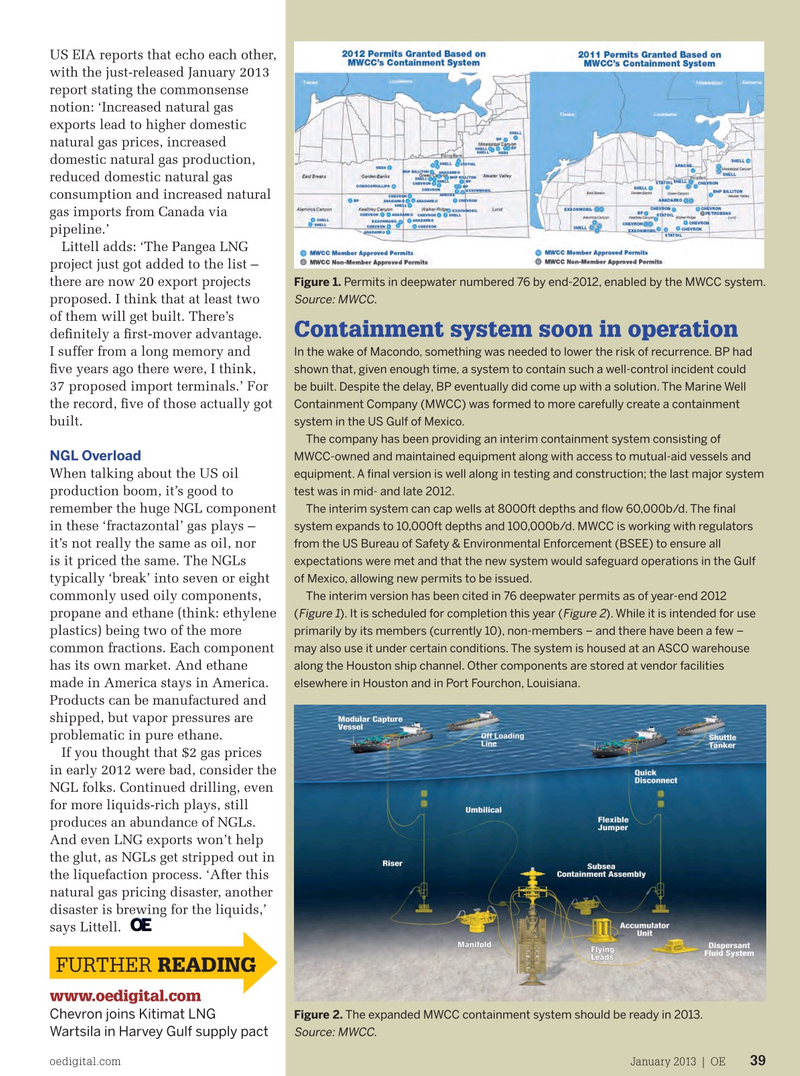
Page 37: of Offshore Engineer Magazine (Jan/Feb 2013)
Read this page in Pdf, Flash or Html5 edition of Jan/Feb 2013 Offshore Engineer Magazine
Global Forecasts 2013
US EIA reports that echo each other, with the just-released January 2013 report stating the commonsense notion: ‘Increased natural gas exports lead to higher domestic natural gas prices, increased domestic natural gas production, reduced domestic natural gas consumption and increased natural gas imports from Canada via pipeline.’ Littell adds: ‘The Pangea LNG project just got added to the list – there are now 20 export projects
Figure 1. Permits in deepwater numbered 76 by end-2012, enabled by the MWCC system. proposed. I think that at least two
Source: MWCC.
of them will get built. There’s
Containment system soon in operation de? nitely a ? rst-mover advantage.
I suffer from a long memory and
In the wake of Macondo, something was needed to lower the risk of recurrence. BP had ? ve years ago there were, I think, shown that, given enough time, a system to contain such a well-control incident could 37 proposed import terminals.’ For be built. Despite the delay, BP eventually did come up with a solution. The Marine Well the record, ? ve of those actually got
Containment Company (MWCC) was formed to more carefully create a containment built.
system in the US Gulf of Mexico.
The company has been providing an interim containment system consisting of
NGL Overload
MWCC-owned and maintained equipment along with access to mutual-aid vessels and
When talking about the US oil equipment. A ? nal version is well along in testing and construction; the last major system production boom, it’s good to test was in mid- and late 2012.
remember the huge NGL component The interim system can cap wells at 8000ft depths and ? ow 60,000b/d. The ? nal in these ‘fractazontal’ gas plays – system expands to 10,000ft depths and 100,000b/d. MWCC is working with regulators it’s not really the same as oil, nor from the US Bureau of Safety & Environmental Enforcement (BSEE) to ensure all expectations were met and that the new system would safeguard operations in the Gulf is it priced the same. The NGLs of Mexico, allowing new permits to be issued. typically ‘break’ into seven or eight The interim version has been cited in 76 deepwater permits as of year-end 2012 commonly used oily components, ( ). It is scheduled for completion this year ( ). While it is intended for use propane and ethane (think: ethylene
Figure 1 Figure 2 plastics) being two of the more primarily by its members (currently 10), non-members – and there have been a few – common fractions. Each component may also use it under certain conditions. The system is housed at an ASCO warehouse has its own market. And ethane along the Houston ship channel. Other components are stored at vendor facilities made in America stays in America. elsewhere in Houston and in Port Fourchon, Louisiana.
Products can be manufactured and shipped, but vapor pressures are problematic in pure ethane.
If you thought that $2 gas prices in early 2012 were bad, consider the
NGL folks. Continued drilling, even for more liquids-rich plays, still produces an abundance of NGLs.
And even LNG exports won’t help the glut, as NGLs get stripped out in the liquefaction process. ‘After this natural gas pricing disaster, another disaster is brewing for the liquids,’ says Littell. says Littell. www.oedigital.comwww.oedigital.com
Figure 2. The expanded MWCC containment system should be ready in 2013.
Chevron joins Kitimat LNG
Wartsila in Harvey Gulf supply pact
Source: MWCC.
oedigital.com January 2013 | OEJanuary 2013 | OE 3939 oe_forecasts3.indd 39 03/01/2013 13:34

 36
36

 38
38